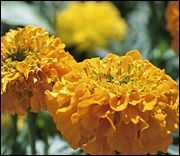Whether you accept it, avoid it or live somewhere in between, insurance coverage has become a defining issue for our profession. Patients increasingly expect to use their benefits, practitioners want to be compensated fairly for their time and expertise, and the system itself remains – at best – fragmented. The encouraging news is that coverage has expanded in meaningful ways. The challenging news is that reimbursement, across the board, remains inadequate.
Herbs & Botanicals
Marigold (jin zhan ju)
What is marigold? What is it used for?
Marigold is a common plant native to the Mediterranean area, but which is now grown throughout Europe, west Asia and North America. It is similar to a sunflower in appearance, with large, scoop-shaped yellow or orange flowers. It is often added to foods such as rice, soups and salads, sometimes as a substitute for saffron, which is more more expensive than marigold.
The flowers of the marigold plant are used medicinally. Much of marigold's anti-inflammatory action is due to its high content of flavonoids. It also contains various saponins and carotenoids.
 Historically, marigold flowers were used to reduce inflammation and fight infections. They were also used to treat a variety of skin conditions, from eczema and skin burns to cuts and ulcerations. Recent evidence suggests they can fight some viral infections; there are also anecdotal (but unsubstantiated) reports that marigold can effectively treat cancer.
Historically, marigold flowers were used to reduce inflammation and fight infections. They were also used to treat a variety of skin conditions, from eczema and skin burns to cuts and ulcerations. Recent evidence suggests they can fight some viral infections; there are also anecdotal (but unsubstantiated) reports that marigold can effectively treat cancer.
How much marigold should I take?
Most practitioners recommend 1-2 teaspoons of marigold combined with 200 ml of boiling water as a tea, with a minimum of three cups of tea per day. Some practitioners also recommend 1-2 ml of marigold tincture, which can be taken with water or tea.
What forms of marigold are available?
Some specialty stores sell marigold flower petals, which can be used to make a marigold tea. Marigold tinctures and ointments are also available.
What can happen if I take too much marigold? Are there any interactions I should be aware of? What precautions should I take?
Marigold has been known to cause allergic skin reactions in some people with sensitivities. In addition, it should not be used by women who are pregnant or lactating. As of this writing, there are no known drug interactions with marigold. As always, make sure to consult with a licensed health care provider before taking marigold or any other herbal remedy or dietary supplement.
References
- Foster S. 101 Medicinal Herbs: An Illustrated Guide. Loveland, CO: Interweave Press, 1993.
- Kalvatchev Z, Walder R, Garzaro D. Anti-HIV activity of extracts from calendula officinalis flowers. Biomed Pharmacother 1997;51:176-80.
- Leung AY, Foster S. Encyclopedia of Common Natural Ingredients Used in Food, Drugs and Cosmetics, 2nd ed. New York: Wiley & Sons, Inc., 1996.
- Newall CA, Anderson LA, Phillipson JD. Herbal Medicines: A Guide for Health Care Professionals. London: The Pharmaceutical Press, 1996.
- Tyler VE. Herbs of Choice: The Therapeutic Use of Phytomedicinals. New York: Pharmaceutical Products Press, 1994.


